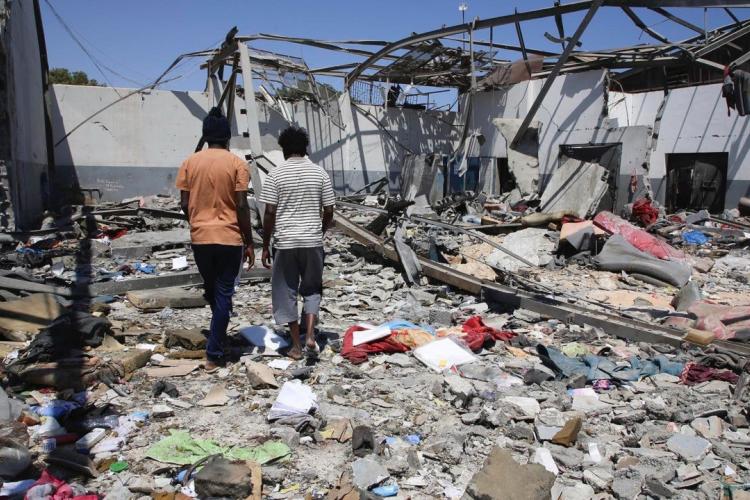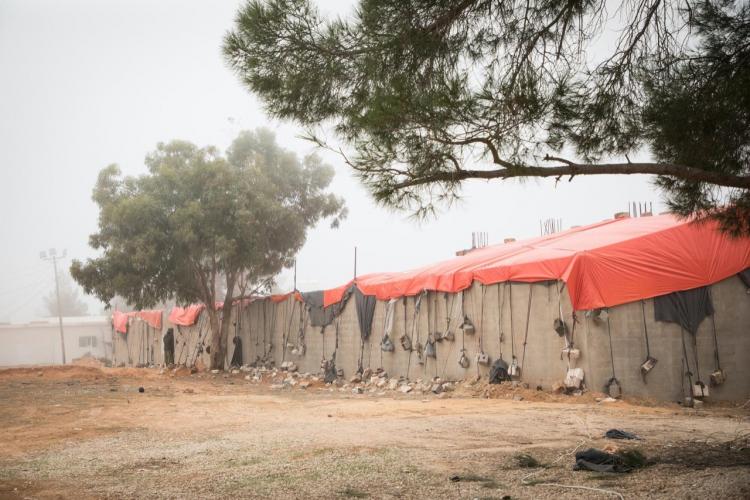Libya’s Figures About Detained Migrants and Detention Centres: Reasons for Recent Fluctuations
Posted:
Time to read:
Guest post by Paolo Cuttitta, Marie Skłodowska-Curie Research Fellow at the IDPS, Université Sorbonne Paris Nord. Paolo’s current research project investigates the relationship between the work of NGOs/CSOs in Libya and the EU-externalisation of migration control. His most recent publications focus on NGOs/CSOs’ borderwork in Tunisia and Egypt , on the criminalisation of search and rescue NGOs in the Mediterranean, as well as on border deaths.
According to official figures, the detained migrant population and the number of detention centres in Libya have both decreased in recent years. In this post, I summarise the reasons for this shift, drawing on interviews I conducted in 2020 with representatives from international organisations, NGOs/CSOs and governmental donor institutions.
The number of people held in migrant detention centres went down from 8,672 in July 2018 to 5,695 in June 2019. In January 2020 it was “more than 3,000” and “roughly 1,500” or “more than 1,400” in April 2020. In September of the same year it increased to 2,467, and was estimated at “some 2,000” or “2,000-3,000” at the end of the year. The number of official detention centres was reportedly 11 in April and 12 in the summer of 2020; over 50% less than in previous years – there were 24 official detention centres in June 2016, 29 in July 2017 and 26 in June 2019.
Αccording to my interviewees, the first reason for this shift was the heightened conflict in the country and, to a lesser extent, the COVID-19 outbreak, both of which made detention centres less manageable. To begin with, Libyan authorities don’t want to take responsibility for migrants’ casualties caused by the civil war. The air strike at the Tajoura detention centre, resulting in the death of at least 53 people in July 2019, urged several centres to release their prisoners, as was confirmed by representatives of an international organisation.

The Tajoura detention centre after the air strike of July 2019
https://www.msf.org/mediterranean-escape-route-migrants-and-refugees-trapped-libya
More broadly, as the head of an international body explained to me, “the intensification of the fighting around Tripoli meant that more militias were needed to defend the capital than to run detention centres. They don’t have the capacity to fight the war and at the same time to run these horrible places”. Indeed, while detention centres are officially managed by the DCIM (the Directorate for Combating Illegal Migration, placed under the Ministry of Interior), they are de facto run by armed groups.
Moreover, managing a detention centre requires resources. Migrants are themselves an important source of revenues, insofar as they are systematically extorted for ransom, forced to work, sold into sexual slavery or to smugglers by detention centre staff. However, my interviewees argued, if militias are busy with the conflict, they can’t exploit detained people as they used to. Consequently, migrants become a financial burden more than a resource, and managers are more likely to release them.
Finally, detention centres are overcrowded and have extremely low hygiene standards, so they are very susceptible to outbreaks, which poses further challenges in times of COVID-19. Not only do some directors release prisoners or even close their detention facilities, some also refuse new guests. An unknown share of the 11,891 people who were disembarked at Libyan ports after being intercepted/rescued and pulled back by the Libyan authorities in 2020 were released after disembarkation because there were no centres available to take them. Incidentally, this was the case even before the pandemic.
Importantly, being released – be it from a detention centre or after disembarkation – is not always the most desirable option for those involved. Many ‘freed’ migrants are in fact subject to forced labour, forced recruitment by fighting parties, (sexual) violence and other abuses in urban settings as well; thus, as representatives of both NGOs and donors told me, people are often reluctant to leave some of the detention facilities, and some of those who left decided to go back to detention centres precisely because they felt safer there.
The second reason for the decrease is that available figures only refer to people held in official detention centres run by the DCIM. However, an unknown number of people are detained in two other categories of facilities. One includes unofficial detention centres, which are ‘officially’ – not just de facto like many DCIM centres – under the control of militias. The other category includes so called ‘data collection and investigation centres’. Like official detention centres, investigation centres are formally under the DCIM but may be in fact run by militias. Investigation centres are often the first facilities where people (e.g. those intercepted at sea and disembarked in Libya) are brought to before being transferred to other places.
Unofficial detention centres and investigation centres do not appear in official statistics. Not only may migrants be transferred from official to unofficial centres, but centres themselves can turn from official to unofficial (and vice-versa), depending on contingent factors, such as the ever-changing relations between the militias running them and the government. Thus, both people and facilities may overnight become dark figures. It is not just difficult to demarcate the number of people detained in unofficial and investigation centres (“we have no idea… I heard from 9,000 to 19,000”, a representative of an international organisation told me), but the number of these facilities too.
Unofficial detention centres and investigation centres have another thing in common: international and civil society organisations are not granted access to these facilities, so no one can provide any kind of assistance or monitor the situation there. The only way for Libyan civil society organisations to try to monitor these facilities is to establish contacts with people who are temporarily allowed to exit the centre to (forcibly) work outside. Without monitoring mechanisms, quality standards – and thus costs – can be kept lower, at the expense of the forced guests. This supports the hypothesis that the decrease in the official number of detained migrants may be counterbalanced by an increase in the number of people held in unofficial facilities.
The third reason might be the pressure from the international community to end detention. Interestingly, this factor was mostly mentioned by European diplomats. Indeed, as an NGO representative argued, it’s “in the interest of the European donors to show that people are being released from detention”, because the idea of a more humane Libyan border regime conveyed by decreasing detention figures suggests that their efforts are worthwhile, and that externalisation is bearing fruits. For the Libyan government, in turn, lower numbers of detention centres and detained migrants mean good publicity in the eyes of the international community.

Dhar el Jebel detention centre, Zintan
https://www.msf.org/libya%E2%80%99s-cycle-detention-exploitation-and-abuse-against-migrants-and-refugees
In sum, we should be cautious when reading figures about migrant detention in Libya. What an official decrease may conceal is a hidden increase in the number of both unofficial centres and people held in such facilities, where they are exposed to even more abuses and excluded from any kind of assistance. At the same time, others are simply released from official centres or after disembarkation, but run serious risks of being abused on the outside as well. The actual number of people detained in all kinds of facilities is unknown, but even if it were lower than in previous years, this would not necessarily be good news. Finally, the slight increase in the official number of detained migrants of late 2020, while peace talks and ceasefires were ongoing, seems to confirm that the main reason for the decrease was the heightened conflict and thus diminished administrative abilities on the part of management authorities. “I think there will be increasingly more people being returned to [official] detention centres. It is not easy for militias to give up sources of revenues”, an international organisation official told me. Despite hosting only a tiny fraction of the migrant population, detention centres play an important role – politically, practically and symbolically – in the Libyan migration and border regime. This is not likely to change in the near future, whatever the outcome of the ongoing peace process. However, in Libya more than elsewhere, migrant detention is a grey zone. Therefore, relevant figures should be handled with care.
Any comments about this post? Get in touch with us! Send us an email, or post a comment here or on Facebook. You can also tweet us.
__________
How to cite this blog post (Harvard style)
Cuttitta, P. (2020). Libya’s Figures About Detained Migrants and Detention Centres: Reasons for Recent Fluctuations. Available at: https://www.law.ox.ac.uk/research-subject-groups/centre-criminology/centreborder-criminologies/blog/2021/03/libyas-figures [date]
Share:








